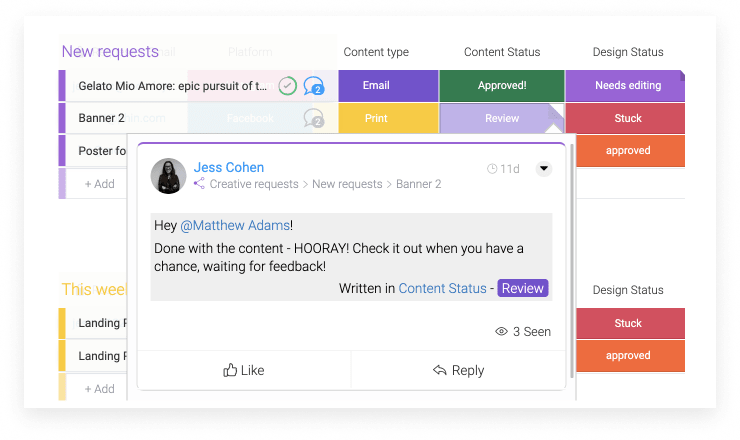According to The Cost of Poor Communications—a survey of 400 companies with 100,000 employees—the average loss per company is $62.4 million per year due to inadequate communication to and between employees.
$62.4 million per year.
In another study from The Economist, Communication barriers in the modern workplace, 44% of respondents said communication barriers are leading to a delay or failure to complete projects. Additionally, 31% reported poor communication resulting in low morale, 25% in missed performance goals, and 18% in lost sales.
In short, miscommunication is having many negative impacts on organizations, teams, and their employees.
Here, we’ll explore some of the common causes of miscommunication and suggestions for improved communication, plus how using monday.com Work OS can help.
6 common causes of miscommunication
While the causes for miscommunication can be varied (and some specific to the individual, the team, or the organization), here are 6 of the more common reasons teams struggle with effective communication.
1. Poor team chemistry: You know that if any team is to have success, they must find ways to work well together. Poor team chemistry often results in conflicts and miscommunication. This is not only unfortunate on an individual level (unhappy employees), it can also be a detriment to the project, and the organization as a whole.
How to fix: Team dynamics can be established and reinforced through daily standup meetings, weekly project calls, individual check-ins, and team building activities. The better a team knows one another, the more likely they’ll be to communicate effectively.
2. Making assumptions: Here’s a scenario: Someone on your team accepts something as accurate, basing it only on incomplete (or wrong) information. When team members make assumptions — without asking for clarification — projects and initiatives can go haywire.
How to fix: Take the extra time to ask a follow-up question until you are certain you understand. Repeat back what you heard, “To confirm, you are saying that … Is that right?”
3. Not practicing active listening: Listening for a break in conversation only so that you can talk, is called “listening to talk” (yes, it has a name!) and quite the opposite of active listening. Active listening requires full concentration so you, the listener, can understand and effectively respond to what the other person is saying.
How to fix: Turn off alerts. Close your laptop (unless you are on a video conference!). Make eye contact with the speaker. Repeat back what they said to ensure complete understanding.
4. Choosing the wrong channel: Email. Slack. Phone. Text. In-person meeting. Virtual (video) meeting. LinkedIn message. In-app message. So many choices. While there is never a perfect communication channel, sometimes one is better than the other. And if you choose the “wrong” channel, messages can get lost, delayed, or left unread.
How to fix: Work with your team to establish “communication channel norms.” Agree on what channels will be used for specific types of conversations. Note: This is often unique per organization and even per team.
5. Not having an open mind: Closed-mindedness is a communication killer. It’s one thing to have strong convictions; totally different not to be open to hearing ideas that differ from your beliefs.
How to fix: Build and foster a team culture that is open to new ideas and perspectives.
6. Lack of transparency: Organizations and teams that operate on a “need to know” basis are doing a disservice to their employees by not being open and forthright. Lack of openness and transparency can have substantial negative impacts on morale and productivity — and result in an overwhelming miscommunication.
How to fix: Take the time to showcase the work of all members of your team. This will help provide a “bigger picture” of what’s happening in your organization by highlighting each and every task.
How transparency helps prevent miscommunication
According to monday.com CEO Roy Mann,
Transparency means making all information—numbers, roadmaps, plans, challenges, and concerns—readily accessible to everyone on your team.
In what transparency in business means to us and why it gets the best results, Mann stresses that transparency is at the heart of the monday.com culture.
Mann: “When you create transparency, you can harness the full intelligence of your team, move faster and smarter, and achieve so much more together.”
And transparent organizations are inherently better at communication.
At monday.com, we build transparency into our day-to-day work by opening sharing who’s working on what, displaying where each task and project stands at any given time, and understanding goals and priorities — even as they shift.
Everyone in the company understands how individual tasks contribute to the big picture and are clear as to what we’re trying to achieve together as a team.
monday.com Work OS: your answer to better communication
While software does not solve every single communication issue, if used appropriately, it will 100% alleviate internal communication issues.
monday.com’s Work OS is the answer to ensuring miscommunication happens less often.
monday.com’s platform enables teams to visually organize projects and tasks in an easy-to-understand manner. Each task has an assigned team member in charge with clear completion deadlines.With monday.com Work OS, your team can:
Streamline your work for maximum productivity: Centralize all your team’s work, processes, tools, and files into one Work OS. It’s easy to connect teams, bridge silos, and maintain one source of truth across your team.
Bring teams together to drive business impact: Collaborate effectively to get a clear picture of your team’s work. Plus, make sure your whole team tay in the loop with easy-to-use automations and real-time notifications.
Communicate seamlessly: Use in-platform messaging to ensure all communication is relevant, timely and contextually makes sense — 100% of the time.

Ready to see for yourself? Get in touch to learn how monday.com Work OS can drive better team communication and collaboration.
